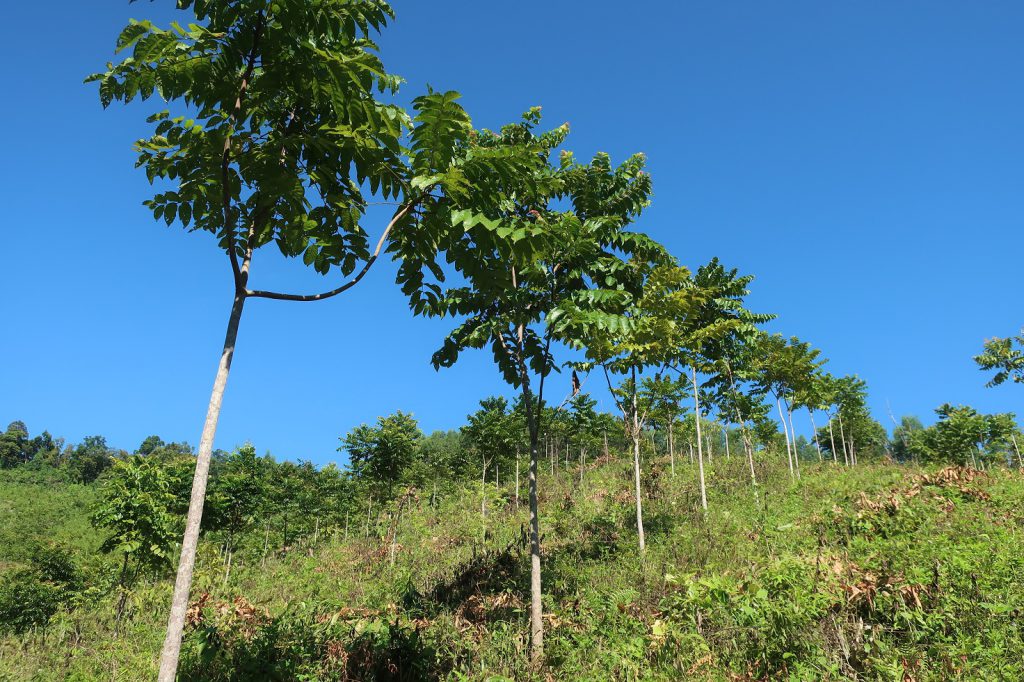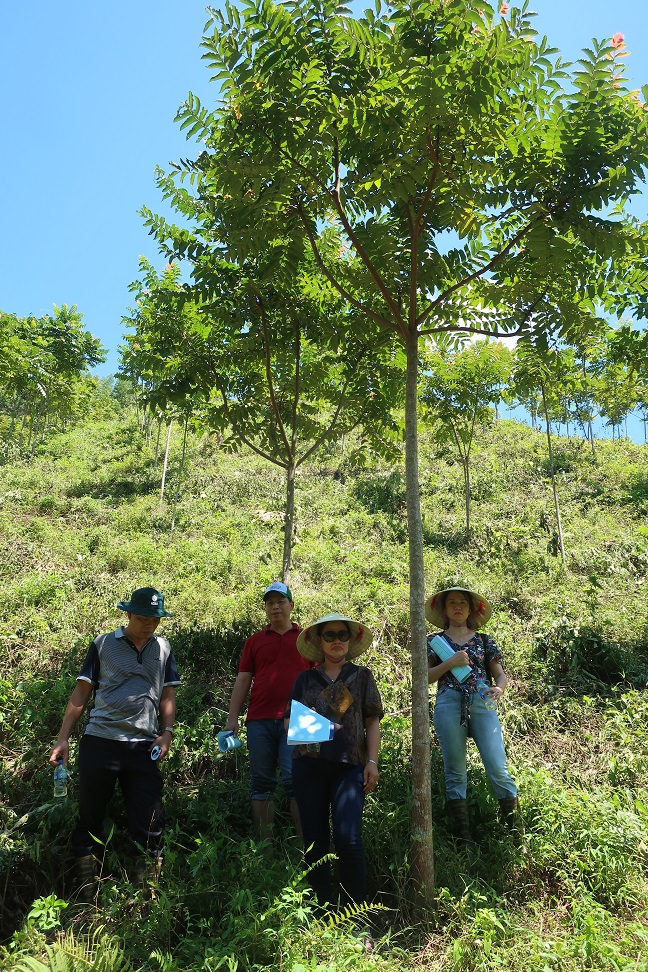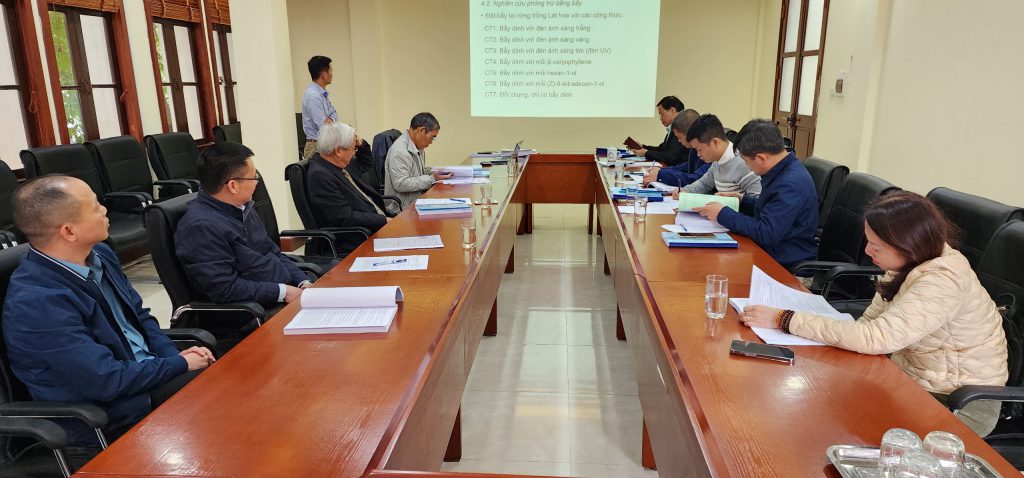GENERAL INFORMATION:
Funding institution: Ministry of Agriculture & Rural Development of Vietnam
Project lead organization: Vietnamese Academy of Forest Sciences
Project implementation organization: Forest Protection Research Centre
Project leader: Dr. Nguyen Minh Chi
Implementation time: 2018-2022
TARGETS AND RESEARCH CONTENTS:
Targets:
– To select 100 plus trees of Chukrasia tabularis in the Northwest and North Central regions.
– To identify at least 1 provenance and 5 families of C. tabularis that show resistance to shoot-tip borer and have growth exceeding 15% of commercial varieties.
– To establish 14 ha of intensive plantings with 15% better growth, and at least 80% less damage from shoot-tip borer than production plantations.
– To identify control measures for management of shoot-tip borer in C. tabularis plantations, and for it to be recognized as technically advanced.
– To develop a technical guide for intensive afforestation of C. tabularis.
Research contents:
Content 1: Research on factors affecting the possibility of damage by shoot-tip borer in C. tabularis plantations, and update the pests and diseases of C. tabularis.
Content 2: Research on breeding of C. tabularis.
Content 3: Research on resistance mechanisms of C. tabularis to shoot-tip borer
Content 5: Research on intensive afforestation of C. tabularis.
Content 6: Development of technical guidelines for integrated pest management of shoot-tip borer, intensive afforestation and training.
Key results:
Chukrasia tabularis plantations in Vietnam are vulnerable to economic loss with more than 50% of trees being damaged by the shoot-tip borer (Hypsipyla robusta). This Project investigated factors contributing to damage and identified technical options to reduce damage and control the pest. The project also developed a technical guide for intensive afforestation of C. tabularis that has been approved by the Scientific Council of the Vietnamese Academy of Forest Sciences.
Chukrasia tabularis plantations were most susceptible to shoot-tip borer at low (>300 m) altitude whereas plantations at 600-900 m altitude were less susceptible to shoot-tip borer. Trees were susceptible to damage at 1-2 years of age. Furthermore, plantations on deep, fertile and moist soils had superior growth and stem form, and were less susceptible to shoot-tip borer damage.
Plus trees (116 in total) were selected in 11 provinces and 2 family trials were established in Hoa Binh (3 ha) and Nghe An (3 ha) provinces. So far, 6 families (LH26, LH32, LH33, LH87, LH97, LH108) and two provenances (Thanh Hoa, Hoa Binh) were identified as having superior growth and tolerance to H. robusta.
Three resistance mechanisms were identified: (1) The presence of physical feeding barriers – trees with shorter internodes, thicker and harder bark, and densely hirsute; (2) The presence of chemical barriers – trees containing antagonistic endophytic bacteria (Bacillus bombysepticus, B. velezensis) or high concentrations of insecticidal limonoid compounds; and (3) The ability of trees to recover (form a new central leader) after being damaged by the shoot-tip borer.
The project identified control measures for management of shoot-tip borer in C. tabularis plantations, and this has been recognized as technically advanced (TBKT 01-115: 2022/BVTV).
Lastly, the Project showed that improved silviculture (e.g. use of inorganic fertilizer, and weed control) could enhance growth and reduce shoot-tip borer damage.
Latest news
- Project: "Research on improving the economic efficiency of plantation timber value chains, meeting legal timber requirements and sustainable forest management"
- Project: Commercial-scale yield trial and completion of planting techniques for newly recognized acacia hybrid cultivars (BV586, BV376, BB055, BV584, BV523, BV434, BV350)
- Project: Study on technology of producing hollow veneer-based composite used in construction and interior wooden furniture
- VFCS is published on the website of the Forestry Department, Ministry of Agriculture, Forestry and Fisheries of Japan
- Memorandum of Understanding signing ceremony on handing over new wood material samples from the Finnish Embassy to the VAFS for displaying
Oldest news
- Vietnam Journal of Forest Science Number 5-2022
- Special Issue Number 2022
- The Annual Steering Committee Meeting in 2022 of the AFoCO Project: Improving Pinus caribaea Morelet for Plantation on Degraded Land in Viet Nam’s Northern Mountainous Region
- Vietnam Journal of Forest Science Number 4-2022
- Vietnam Journal of Forest Science Number 3-2022









